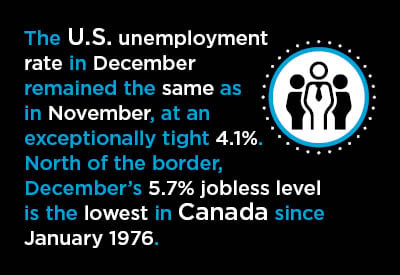U.S. net total jobs creation in the final month of last year was a tepid +148,000, according to the latest Employment Situation report from the Bureau of Labor Statistics (BLS). The ‘weakish’ December result caused the monthly average throughout all 2017 to pull back slightly to +171,000.

Just the same, +171,000 as a monthly average in 2017 signifies a more than satisfactory performance, although it was down from 2016’s comparable figure of +187,000.
The U.S. unemployment rate in December remained the same as in November, at an exceptionally tight 4.1%.
The seasonally adjusted (SA) number of U.S. construction jobs recorded a nice gain in December of +30,000. Such a substantial increase in employment for on-site workers was the biggest leap since February 2017’s +54,000.
Construction’s average monthly gain in jobs in 2017 was +18,000, which compared favorably with 2016’s average monthly rise of +13,000.
The latest monthly construction jobs hike centered mainly in residential (+10,000) and non-residential (+14,000) specialty trade contracting.
But the biggest news for construction lay in the compensation figures. For all construction workers, including supervisory personnel, average weekly earnings soared +4.0% year over year, the best gain for that ‘metric’ since December 2015’s +4.0%.
For construction workers excluding bosses, the average weekly earnings climb was an even more impressive +4.7%. The last time +4.7% was matched or exceeded occurred in September 2016, at +5.2%.
Year-over-year hourly earnings for construction workers in December were +3.0% including bosses and +3.1% leaving out bosses.
Wages for all U.S. workers economy-wide, however, continued to be subdued in the latest month. Including supervisory personnel, average hourly earnings were +2.5% and average weekly earnings, +2.8%.
Omitting bosses, average hourly earnings for all workers were +2.3% and average weekly earnings, +2.9%.
The bottom line is that wage gains for most jobs are still meeting resistance at the +3.0% level.
Another sector registering significant month-to-month jobs growth in the latest month was manufacturing, +25,000. Over the past five months, production-line firms have expanded their payrolls by +132,000 jobs.
Monthly average manufacturing sector employment in 2017 was +16,000. In the prior year, 2016, manufacturing sector employment stayed flat, on average, throughout the 12 months.
Other major industrial sub-sectors with sizable month-to-month jobs hikes in December were ‘leisure and hospitality’, +29,000, and ‘education and health services’, +28,000. The former was particularly bolstered by ‘food services and drinking places’, +25,000, while the latter was all driven by ‘health care and social assistance’.
Within health care, ‘ambulatory services’, 15,000, and ‘hospitals’, +12,000, provided the hiring momentum.
‘Professional and business services’ jobs creation in the latest month was disappointing, only +19,000. Employment in ‘accounting and bookkeeping services’ took an especially bad turn, -15,000.
On average in 2017, ‘professional and business services’ provided +44,000 net new jobs each month, exactly the same as in 2016.
Shocking on the downside in December was a -20,000 month-to-month jobs performance in the retail trade sector. The contraction in staffing at ‘general merchandise stores’ was -27,000. But keep in mind that the foregoing two declines are expressed in seasonally adjusted (SA) numbers.
Thanks to gift-giving over the winter-break holiday season, December is the busiest shopkeeper month of the year. The month-to-month not seasonally adjusted (NSA) retail trade employment number in December 2017 was +59,000.
Canada’s Unemployment Rate Lowest since 1976
North of the border, December was another banner month for employment, according to Statistics Canada. The latest Labour Force Survey records a shrinkage in the unemployment rate from 5.9% in November to 5.7% in December.
December’s 5.7% jobless level is the lowest since January 1976, over fifty years ago.
Net total jobs creation in Canada in December was +79,000, coming directly on the heels of +80,000 in November. The latest two months have generated nearly +160,000 new jobs, a stunningly upbeat increase. The December 2017 over December 2016 climb in total jobs in Canada was +423,000.
By comparison, America’s December 2017 over December 2016 addition to total jobs was +2.1 million − but the population of the U.S. is nine times bigger than Canada’s.
Part-time work in Canada soared in December, +55,000, but the increase in full-time work was also respectable, +24,000. At the same time, the private sector was more active in hiring than the public sector, +57,000 compared with +22,000.
Canadian construction employment in December was +7,000 month to month, while manufacturing employment was -4,000.
On a year-over-year basis, manufacturing employment has made more headway than construction employment, +85,000 compared with +51,000.
Regionally, every province saw a drop in its unemployment rate in December 2017 relative to the same month of the year before. Quebec (moving from 6.5% in December 2016 to 4.9% in December 2017) and Alberta (from 8.5% to 6.9%) had the greatest improvements.
It’s British Columbia, however, that can boast of having the lowest jobless rate in the land, at 4.6%.
As for year-over-year jobs growth, the leaders among the provinces have been: Prince Edward Island, +3.9%; B.C., +3.4%; and Ontario, +2.5%.











Recent Comments
comments for this post are closed